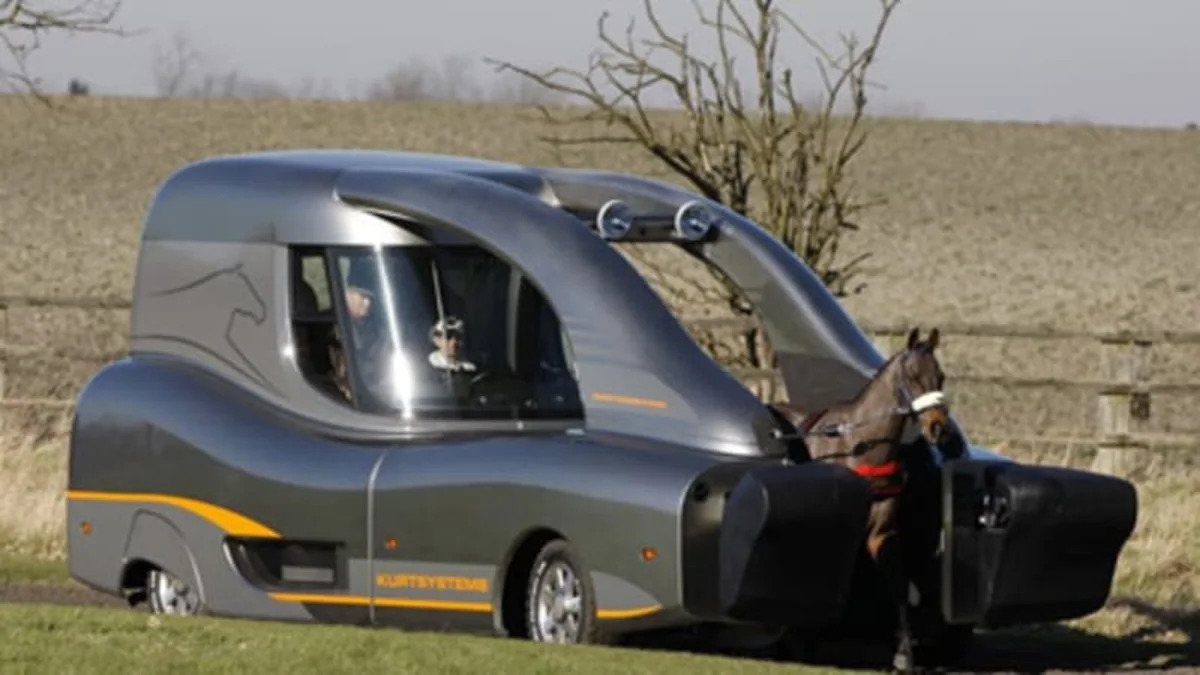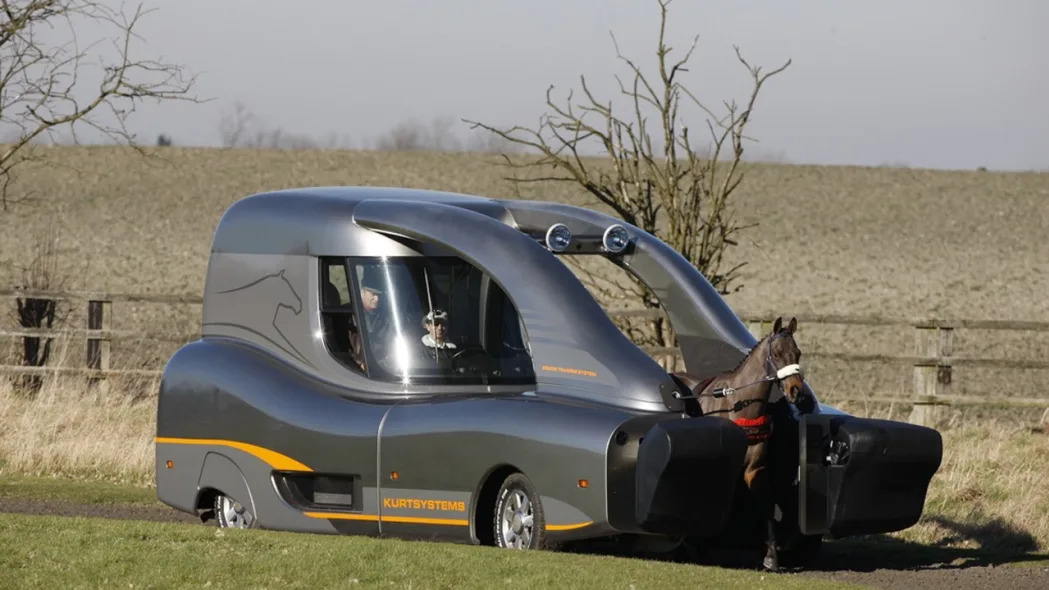Click above to view high-res gallery of the ROUSH trainer
We wind up behind horse's asses every day on the interstate, but ROUSH has developed a vehicle with a rear-mounted cabin for the express purpose of towing a crew of three around while staring at the business end of an actual Equus caballus. ROUSH Technologies is more than just mechanical Mustangs, and the company has proved it by developing an equine training vehicle for Kurt Systems, a Turkish racehorse and camel training equipment company. The vehicle has an open front stall where the animal can run, and a rear mounted cabin that allows a driver, a veterinarian and a trainer to keep a keen eye on vital signs. The suspension is partially F-150 based, while power is provided by Volvo's 2.4-liter five-cylinder engine hooked up to an automatic transmission and driving through some reduction hardware. The vehicle will start serial production soon; in an odd sort of irony, ROUSH is even further tied to fast horses now. Press release after the jump.
We wind up behind horse's asses every day on the interstate, but ROUSH has developed a vehicle with a rear-mounted cabin for the express purpose of towing a crew of three around while staring at the business end of an actual Equus caballus. ROUSH Technologies is more than just mechanical Mustangs, and the company has proved it by developing an equine training vehicle for Kurt Systems, a Turkish racehorse and camel training equipment company. The vehicle has an open front stall where the animal can run, and a rear mounted cabin that allows a driver, a veterinarian and a trainer to keep a keen eye on vital signs. The suspension is partially F-150 based, while power is provided by Volvo's 2.4-liter five-cylinder engine hooked up to an automatic transmission and driving through some reduction hardware. The vehicle will start serial production soon; in an odd sort of irony, ROUSH is even further tied to fast horses now. Press release after the jump.
[Source: ROUSH]
PRESS RELEASE
Roush Goes Under Starters Orders!
Roush Technologies has just completed a groundbreaking bespoke vehicle project for Turkish-based, Kurt Systems – a world leader in racehorse and camel training equipment. The ground-up, turnkey project involved the design, development and build of a highly complex mobile race trainer which enables continuous monitoring of the animal at speeds of up to 60kph.
The striking and unusual looking machine incorporates a number of innovative and unique vehicle systems, as well as a diesel engine, automatic transmission and a spacious luxury cabin for a crew of three. Weighing in at around 4 tonnes, the vehicle effectively provides a moving enclosure similar to a starting stall, in which the animal can walk, trot or full gallop freely in a controlled environment, whilst being monitored and trained to optimise race performance.
The spacious cabin, which is mounted rearward of the horse, includes a centrally mounted driver's seat, plus additional seats for a trainer and a veterinary specialist. Onboard systems include 12-volt and 240-volt electrical supplies, to power systems such as computerised heart, blood, oxygen and fitness monitoring. The unit also carries a range of precision hydraulically controlled accessories, such as a silicone saddle to simulate jockey weights.
The open fronted stall section of the vehicle requires linked independent hydraulic steering, combined with electronically controlled reins, to steer the horse in the same direction as the vehicle. The reins are enclosed within two forward curving booms on the body structure, controlled by the driver.
The chassis and running gear comprise a complex, box-section, cross-braced frame, with suspension derived from a Ford F150 series truck. Power is provided by a Volvo 2.4litre, five-cylinder diesel engine, driving through a conventional automotive automatic gearbox – and final drive is delivered via hub reduction on the rear axle only. Speed is precisely controlled from walking pace up to race conditions, up to a maximum 60kph (16 metres per second). The purpose-built body is fabricated primarily from GRP – with the forward 'stall' area enclosed by soft, padded, pneumatically controlled arms, which surround the horse when required.
Roush Executive Chairman, Andrew Williams says, "The Kurt equine trainer programme is an unusual but powerful example of the diverse engineering capability which exists within our company. Here is a commissioned project for an overseas-based world leader in its field, coming to Roush for its ability to follow through a concept upwards development, through to pre-production product maturity. The project needed to draw from our extensive automotive and specialist vehicle experience – but combined with systems integration knowledge at the most sophisticated level".
Kurt Systems General Manager, Daniele Camuffo says, "The Kurt Group is the acknowledged world leader in single and multiple equine training systems, which provide horse-welfare sensitive, but scientifically appropriate training regimes for the 21st century racing industry. We turned to Roush in the confidence that its combined range of complementary vehicle and systems experience would provide us with a successful on-track and off-track single-horse trainer, able to meet the increasingly sophisticated demands of the race industry worldwide. These units will now enter serial production and we believe that our approach to controlled environment training will become established practice with many studs and stables at this level".



Sign in to post
Please sign in to leave a comment.
Continue